Erasmus+ Journal (Issue 2) 2013/14
Nina Trojer, Maria Rainer, Denmark, University College Syddanmark, Mobility for Studies
Authors: Nina Trojer, Maria Rainer
Overview, History
The little town Haderslev is situated on the east coast of Southern Jutland in Denmark and has a population of around 21,000 people. For four months we had the pleasure of being among them.
Haderslev was founded by Vikings and became part of royal Denmark in 1292 as a main trading centre. In the 16th century, the city was one of the first Scandinavian places to embrace the Lutheran Reformation. In the 19th century Haderslev was part of the German Empire until 1920 when it was returned to Denmark.
In earlier times there were watchmen who had to prevent the town from fires and make sure that there was peace and order. These watchmen still wander around in the town today, singing songs and telling visitors everything they want to know about Haderslev.
Because of its history and location near the German border, you will notice that there are many people who can understand and speak German very well and you will even find German schools and kindergartens.
If you walk through the town you will see lovely little houses, an impressive church, the ‘Domkirke’, a nice shopping street, green parks, a small harbour and an old outdoor museum. Twenty minutes away by bus you can enjoy a great day at the beach.
The University College Syddanmark consists of five different campuses: Esbjerg, Haderslev, Kolding, Aabenraa and Sønderborg. Around 1,200 students attend the university college in Haderslev. They offer a great variety of studies: Business Language and IT-based Marketing Communication, Graphic Communication, Media Sonic Communication, Nutrition and Health, Physiotherapy and Teacher Education for Primary and Lower Secondary Level. Due to the fact that all these study programmes are taught in Danish, the university college offers international classes in English, for instance for Teacher Education as well as Erasmus courses.
The campus consists of several brick buildings which are well equipped with smartboards in each classroom, a few pianos which everyone can use, a kitchen, cafeteria and sports hall.
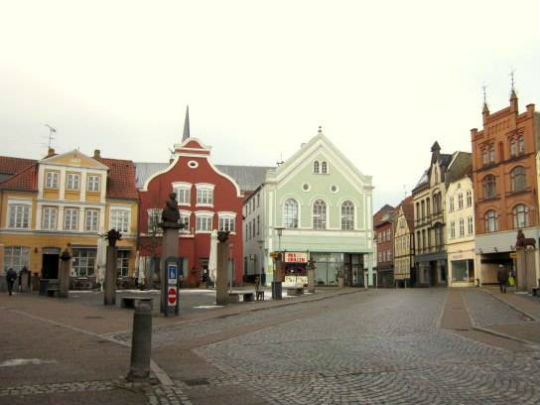
Haderslev (Photo: Maria Rainer)
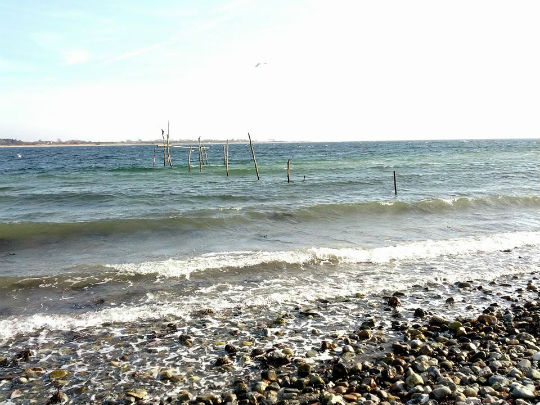
Danish Sea (Photo: Maria Rainer)
Differences between the education systems
Most Danish schools are called ‘Folkeskole’, which are schools for classes 0 to 9.
This means that the children spend all their compulsory schooling together without classification.
For me this is one of the big differences between the Danish and the Austrian school systems.
In Austria, children are divided into several types of school after four years of primary school. In my opinion, this is counter-productive and creates a certain social inequality early in life.
The Danish system showed me that this inequality could be largely eliminated, if all the children stayed together until they finish compulsory education.
I think this is one of the reasons people in Denmark are generally treated more equally, regardless of how they make their money. I believe it is due to this sense of ‘classless’ society, that Danes seem, and probably are, happier, than we Austrians.
Another thing that particularly stood out to me is the relationship between teachers and their pupils. Both treat each other in a warm, respectful manner: for example, a pat on the back or the children giving their teacher a hug is not a rarity.
Discipline is a word that is more or less unknown in Danish schools and Happiness and “Hygge” is much more important in Denmark than in Austria – in my opinion that is the reason why Danish children don’t need to be tested all the time.
If the surrounding is cozy and the atmosphere is positive, it seems logical to me that children will learn better and more easily and enjoy it more.
The Danish slogan is “We learn for life.”
These aspects are also part of higher education in Denmark.
Teachers and professors are addressed by their first names and treat their pupils and students in a very friendly and open way.
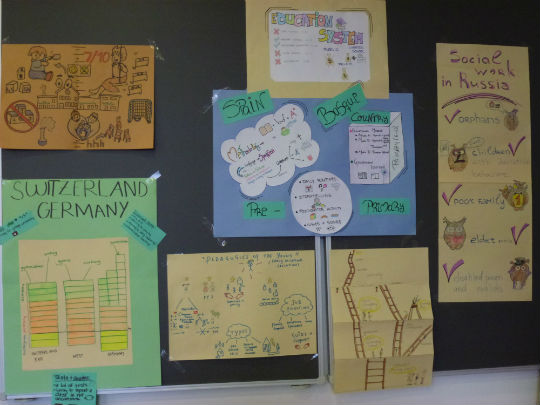
Different School Systems (Photo: Nina Trojer)
School and field experience
During our stay in Haderslev we twice had the chance to visit Danish schools to teach and be taught there.
The first school I visited was the “Kristne Friskole”.
It was very instructive to stay there, because we had the chance to be part of the project week and this way we could explore how well Danish children can work independently. The results of that week were really amazing. The normal lessons in that school were a bit boring for us, because most of the time we were only watching the teachers giving lessons we couldn’t understand in Danish.
Our second school practice was different – it took place in the German school, so we were able to teach by ourselves.
We spent about one month in that school and were treated like normal teachers. We worked closely together with the other teachers in the school and this way we got many useful ideas for good lessons, much advice and also links to nice websites to use in school.
It happened more than once that we were sent to teach a class on our own, when the teacher was absent- it was a great experience and, I guess, being forced to be spontaneous and independent is a very good way to get a taste of our future job as teachers.
Maria Rainer
During my stay in Denmark I had the opportunity to visit five totally different schools: Haderslev Kristne Friskole (Christian school), Vojens Gymnastik- & Idrætsefterskole (boarding school specialising on sport), VUC Syd (most modern school in Denmark), Fællesskolen Favrdal Fjelstrup (Danish school) and Deutsche Schule Hadersleben (German school).
Fællesskolen Favrdal Fjelstrup
My first field experience took place in Fællesskolen Favrdal Fjelstrup.
The school campus consists of many brick-buildings and the school hosts kindergarten, primary and secondary school.
Two colleagues and I got the chance to observe various lessons in English with different age groups, wonderful students and motivated teachers.
We soon found out that the students’ level of English was quite good and they really wanted to talk to us and find out more about our home countries and us.
The teachers encouraged us to participate actively and do projects with the students. For instance, we were interested in the matter why Danish people are said to be the happiest in the world. We read some articles in class and found out that possible reasons could be that education and health care are for free, Danes cycle a lot and that they are masters of “hygge”, which means cosiness.
I was impressed to see that the use of technical equipment is a natural part of teaching. All teachers used the smartboards, the students could use the school’s laptops and some 6th graders produced their own movies on iPads.
These two weeks in a Danish school gave me some insight into the differences between the Danish and the Austrian education system.

Fællesskolen Favrdal Fjelstrup (Photo: Nina Trojer)
Deutsche Schule Hadersleben
I could spend my school experience in May, which lasted four weeks, at a German school. For many students German is not their first language and so they try to talk a lot in Danish.
There are German and Danish teachers who did their degree either in Germany or Denmark. All teachers speak German fluently. The school combines the rigid German education system and the open Danish system.
All lessons, except the Danish classes, are taught in German and the students have to communicate in this language as well.
My advisor was class teacher of 3rd grade. So I spent most of my time with this class. I observed German, Math and Music lessons and helped whenever I was needed. The whole group started together with a new topic and after a short introduction they continued to work alone or with partners. It was obvious that the children were used to doing their work independently and it was always really quiet in the classroom.
Sometimes the class teacher had other responsibilities to do and so I had to step in and finish the lesson. I learned to be flexible and spontaneous because I had to teach other subjects than the ones I study. Nevertheless, it worked quite well and was a good experience for my future teaching career.
I could also teach some lessons in English in 4th and 5th grade. The teacher told me what the topic would be and I planned and taught the whole lesson.
I really enjoyed the time I spent in the Deutsche Schule Hadersleben.
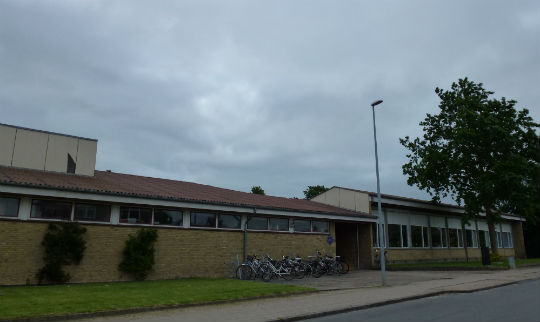 Deutsche Schule Hadersleben (Photo: Nina Trojer)
Deutsche Schule Hadersleben (Photo: Nina Trojer)
Austrians want to be powerful – Danes want to be happy
Now I would like to give you insight into my experience with the Danish education system in comparison with the Austrian one.
The first thing an Austrian will notice when entering a Danish classroom is that the students call the teacher by his or her first name. The relationship between adults and children is very close and from the students’ perspective there seems to be no signs of fear of the teacher.
I always thought that it is essential for a teacher to keep distance to the students and to use a formal register because otherwise they will not respect the grown-ups.
But the Danish school system shows that it can work differently. In Denmark you can experience a feeling of equality which is hard to find in Austria. The big distance in our system just gives our teachers power to make them feel self-confident. We are trained to show respect but a person should not be respected because of his/ her position but of his or her behaviour.
The fact that students do not honour adults and call them bad names can happen everywhere, no matter if you call the teacher by his or her first name or surname. It is important to take the students seriously and that teachers are interested in them. Only if you do that you can earn their respect.
If you can call a person by first name you do not get the impression that he or she is unapproachable. It is also easier for students to go to a person that is closer to them if you have problems or just want to ask when you have not understood everything.
The Danish society wants young people to be prepared for life. The government puts a lot of money into technology because it appears that they see the future in technology. Therefore, all classrooms are equipped with smartboards and a certain amount of laptops for the children which teachers as well as students know how to use. It is not only amazing to observe that the teachers are willing to change their teaching style and use modern technology to teach but also that the teachers really use it all the time.
On the one hand using the newest technology can be really motivating for the students because it is part of their world. On the other hand always sitting in front of the screen and using programmes to create e. g. posters can make the students forget to use their own imagination and creativity.
A good way to deal with this matter is to alternate in using blackboard and smartboard, laptops and books or iPads and pens.
For Danish schools there is no fixed curriculum which tells the teachers what to teach in class at a certain age or time. The teachers can decide on their own what they want to teach, when to teach it and how much time they want to spend on a topic. Consequently, there is no time pressure and so they can focus on different teaching and learning methods, like group work, and let the children work independently.
Compared to our system which follows a strict curriculum it might be a good thought if the teacher can choose the topics. He or she can find out the interests of the students or determine topics which are relevant at a certain time. Having a curriculum like in Austria helps to make sure that all young people have the same knowledge. However, it is motivating for a class if they can choose on their own which topics they want to cover in class.
In the Danish school students do not get marks until 9th grade. The fact that the Danish education system works without giving grades and having tests might be surprising for an Austrian person. Before that they receive verbal feedback each semester. The children do not write tests but they have to do homework and the teachers lay emphasis on group work and presentations. Therefore, there is less pressure on the children in doing well at school and almost no competition because the students are not compared with each other. Still, the students seem to be motivated and willing to study. We should think if we should change the Austrian way of putting pressure on our children by doing tests all the time.
In my teaching career I would like to find a balance between doing no tests and comprehension checks at all and doing exams every week.
When you ask a Danish teacher if a lot of students have to repeat a class you might find yourself looking into a confused face. The teacher will probably ask you why they should redo a class. In their opinion making someone repeat a year shows them at a really young age that they fail and are not able to achieve anything in their life.
There are also students who take advantage of this system and are lazy. But this can happen in almost any education system. A nice way to deal with those students might be to let them stay in their environment with their friends and make the students aware that they are good at something. It should be important for a society that its members are happy.
Although I do not agree with everything, I must say that the Danish way of teaching is really inspiring and the experiences in this country made me very happy.
The school experience allowed me to get a better understanding of the Danish education system and I would like to take some ideas from this system back to Austria.
One thought I will definitely keep in mind is: “You don’t learn for school, you learn for life!”
Nina Trojer
University Courses
Erasmus course: LIVING AND LEARNING TOGETHER
February to May 2014:
In English
Courses at university: 20 ECTS
School and field experience: 10 ECTS
Target groups:
- Student teachers for pre-school, primary and secondary school
- Students studying social education
- Students studying to become Bachelors of Health and Nutrition
Goals:
The course will provide students with skills, knowledge and experience to increase their intercultural competence, i.e. the ability to live and work in heterogeneous groups. They will be made aware of the qualities of other teaching and learning traditions and can reflect on their new experiences through the use of weblogs, …
1. Introduction to Denmark and the Danish language: 2 ECTS
- general introduction to Denmark, Danish history, culture and society
- crash course in the Danish language at the Language Centre (Sprogskole)
In the first two weeks we had to read a text about Denmark, compare it with our own country, make a presentation using Glogster and present it to the others. As we were students with ten different nationalities we discussed a lot about the Danish culture and society and what we had noticed so far, as well as about our own.
When you want to stay in Denmark for a longer time it is obligatory to attend Danish lessons at the Language Centre. So we spent two hours two times a week for two months at the Sprogskole. The language is really hard to learn but our teachers did their best in teaching us and were very patient with us. With the help of our teachers and in group work we managed to learn basic vocabulary and useful phrases.
2. European Education and Welfare Studies: 10 ECTS
- Edutopia: create your perfect school
- History project: Through use of ICT and creative and active learning we will furthermore experience different historical episodes in Europe and how they affected people in different countries.
- Project work: planning and arranging the International Week
- Book: Momo; reading, reviewing, thinking about the context of the book
- Freedom Writer: get to know the Freedom Writer pedagogy and write your own story
- Health and Nutrition
- Work methods: use of ICT tools by creating cartoons, homepages, …
- Learning process and assessment: blogs and a final project: a written and oral presentation of a specific educational and professional problem
European Education and Welfare Studies consisted of different classes and projects which all affect society and our own lives in one way or another.
One big topic was called “Edutopia”. We discussed in groups about the current school systems we knew and created a new one of which we thought was the perfect one. This wasn’t very easy and we noticed that we were still stuck in our own education system as well as society that it was hard for us to think about a system which can suit everyone. In the end the results were quite different and it was good to hear the thoughts of the different groups.
Another project was the history project. We had the task to interview someone from our own country about a topic which we could choose on our own. In this project we had to deal with our own country’s history and society’s background, the opinion of people or a person’s own story. The students gained an overall understanding when listening to other country’s background and problems.
In the first week of April an International Week took place at the campus in Haderslev. Students from different partner universities spent one week in Haderslev and even stayed at our apartments. The Erasmus students were in charge of arranging projects for them during the week. For example, one group was responsible for planning and doing get-to-know-each-other-activities, some others worked with them on the perfect school system and another group prepared hot dogs and an international evening for them. We didn’t only get to know various people from several countries but also felt what it means to be responsible and plan and think of activities.
In another class we had to read the book Momo, or the strange story of the time-thieves and the child who brought the stolen time back to the people. Reading the book Momo makes one really think about his/ her usage of time. We discussed the topics time, stress and happiness in those lessons and it was interesting to listen to the teacher’s lecture and the colleagues’ opinion on the moral of the story.
We were introduced to the Freedom Writers’ methodology which is based on Erin Gruwell’s pedagogy she used in school to help young people overcome their fears and past and write about their life. The end product of this class was a book we all wrote together, called Everybody Has a Story. Erasmus 2014. Campus Haderslev, with stories, poems and pictures made by the Erasmus students.
You can find (and buy) our book on amazon.de:
http://www.amazon.de/Everybody-Has-Story-Erasmus-Haderslev-ebook/dp/B00KCM1YRE/ref=sr_1_fkmr0_1?ie=UTF8&qid=1400507813&sr=8-1-fkmr0&keywords=everybody+has+a+story+torbjorn
Another interesting part of this module was the class with students from the study “Nutrition and Health”. They told us a lot about healthy food and where we could find it in Danish supermarkets. We prepared together with them typical Danish food.
During this module we had to participate in class, discuss in groups, draw posters, work with ICT, create cartoons and homepages, write our own blog and just be creative. We had to do a written assignment for the Momo class and also one final paper about school practice, but the topic we could choose on our own. We had to do shorter and longer presentations about various parts of the module, like Edutopia or the History project, and a final one at the end of the semester, either alone or in groups. The main aspects of doing a good presentation at Danish universities are to use technology and to make it interesting by for instance singing a song or making your own movie and including the whole group, for example creating a story all together.
During the whole semester we were definitely kept busy with all the different presentations we had to prepare, texts to read and cartoons to make but it was a wonderful time. It great to learn about other countries and school systems, to have fun with new people, discuss about serious topics and to talk in English all the time or even try to use words from other languages.
Everyone, not only future teachers, should take part in such a course because it broadens your horizon and makes you question things that you have always taken for granted.
3. School or field experience (2 weeks): 3 ECTS
- Observation, fieldwork, practical work, or teaching at schools and institutions. Visits to relevant institutions
In March we had two weeks of school practice, where we observed lessons in Danish schools and got to know the Danish education system which is very different to the Austrian one.
4. Choose either the a, be, c, or d option: 5 ECTS
a. Learning through creative and practical experiences: Art, Film, Outdoor Learning and Drama
In this module the students created their own Ibooks, cooked pancakes over a real fire place, made a movie about different countries and cultures and did some really nice artworks.
b. Food and Sports
The students who chose “Food and Sports” created, cooked and learned about healthy food and did different types of sport.
c. English
In “English” the students got to know different learning strategies and did presentations about them.
d. German
5. School and field experience in month 4
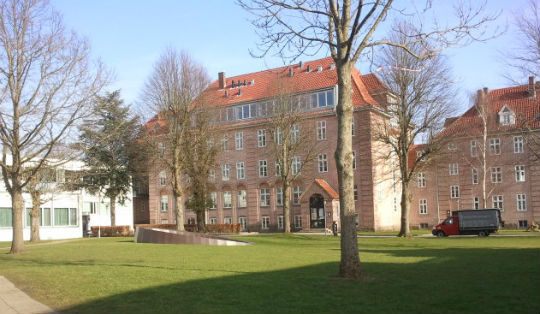 Campus Haderslev (Photo: Nina Trojer)
Campus Haderslev (Photo: Nina Trojer)
Application and Registration
Online Registration: The University College of Syddenmark uses a platform called Blackboard, which works almost the same as the PH Online Website. As a student you get a username and a password, with which you can enter the side to see your timetables and to send your homework etc.
Selection of Courses: Most of our curses had been selected for us, but we had the possibility to choose one course according to our personal interests (see section “Lehrveranstaltungen”)
Learning Agreement: This form had to be filled out to make sure that you and the university agree to your courses and schedules.
At the end of the term the university handed us out our certificates.
Contacts
Campus Haderslev
Lembckesvej 7
6100 Haderslev
Danmark
http://www.ucsyd.dk/
Erasmus Coordinator:
Carolin Parusel
Tel.:+45 7266 5222
E-Mail: cpar@ucsyd.dk
International Assistant:
Tanja Løwe Sørensen
Tel. +45 7266 5011
E-Mail: taso@ucsyd.dk
Tanja does a great job in managing all the important details of our Erasmus stay in Denmark. We could always ask for help and she solved our problems as quick as possible.
Accomodation
When we arrived on 27th January at around 11pm at the bus station in Haderslev we were picked up by our buddies, two girls who also attend the university, and brought to our accommodation.
Grøftholtvænget
My buddy Nehrida and I took a cab, paid by the university, to my apartment. It was dark and cold outside and I was really tired from spending a whole day in several trains.
For me, it seemed like an eternity until we finally reached the bungalows. I stumbled out of the car into snow, took my bags and followed my buddy to my flat. The few things I could make out in the dim light weren’t so welcoming. I seemed to have ended in the middle of nowhere. I could only see some buildings which all looked the same, surrounded by nature.
In daytime it looked different and after a few days I felt quite comfortable living in my new flat. The whole area consists of around 50 apartments for one or two people. There weren’t only students living there, but also people who are already working or mothers with their daughters. The flats have one bathroom, two big rooms with a bed, desk, chair, lamp and wardrobe, one kitchen with table, two or three chairs, oven, cooking elements, fridge, freezer and cupboards. The most necessary kitchen utensils are provided as well, although we had to buy some other useful stuff.
In an extra room there are two laundry machines and one dryer which everybody can use. Your rent includes an amount of 100 kroner per month with which you can use the laundry machine and dryer.
There is also a common room with bathroom and kitchen which everyone can use. We had some parties there, of course!
If you have any problems with your flat, you just need to text the university and they will send the janitor to your place.
I lived with a girl from Spain who also attended the Erasmus course. As I found out, there were nine other Erasmus students living next to us. It was great that we lived all together, so you never felt lonely or when you ran out of food or something you could just knock on the door next to your flat to get what you need and when looking out of the window you could see what was going on outside.
Soon I noticed that it was a long way to walk to university, almost half an hour. But it was also a lot of fun because many of the Erasmus students walked together. Compared to Austria, Denmark is a very flat country, but Grøftholtvænget was situated behind the only real hill in Denmark. So in the morning we had to walk up the hill and walk it down and in the afternoon the same. By the second week we were able to rent some bikes, but had a hard time going up the hill, but it was much faster than walking, even with the typical Danish wind in our faces.
Although I thought in the beginning that my apartment was way too far away from the university and the city centre, I soon was more than happy with my flat. For me, this area was the most beautiful part of Haderslev, surrounded by green fields, flowers, horses, cows and green forests.
Grøftholtvænget
6100 Haderslev
Rent: 2950 kroner = around 400 €/ month
Pay in cash at university or via telebanking
Laundry/ drying machine: 100 kroner included in rent; 10 kroner/ 1x
Common room
Free parking lot
Apartment for two:
2 bed rooms: bed, table, desk, wardrobe, lamp
kitchen: table, chairs, oven, cooking elements, fridge, freezer, cupboards, plates, bowls, cutlery, pots, chopping board
bathroom
Distance to university: around 3 km
Time to university: 30 min when walking
Time to university: 15 min when going by bike
Nina Trojer
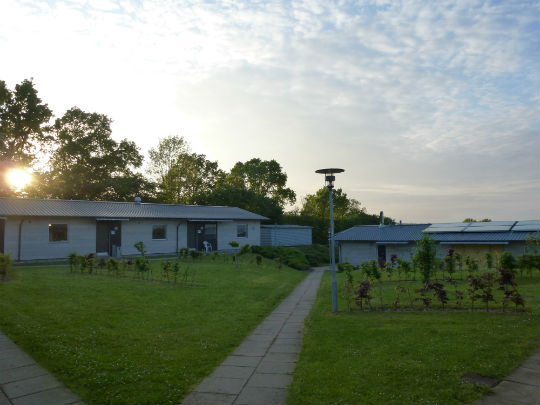 Grøftholtvænget (Photo: Nina Trojer)
Grøftholtvænget (Photo: Nina Trojer)
Slagtergade
Before arriving in Denmark I couldn’t imagine how my new home was going to look and, to be honest, I expected the worst. So I was more than happy when I first opened the door to that cosy, little, orange house which was going to be my new home.
We were four people sharing a house on three floors. Everyone had their own room with a bed, a desk, a chair and a wardrobe. We had a nice, sunny garden with furniture, a huge living room containing a couch and a big dining table, two bathrooms and, of course, a kitchen with all kinds of useful kitchen stuff. In an extra room there was also a laundry machine and a dryer which we could use for free any time we wanted.
The house was situated perfectly – it took us a five minutes walk to get to the university and on the other hand only five minutes to get in the middle of the city centre.
Same as in the Grøftholtvænget the rent was about 3000 kroner (about 400 Euros) a month.
Maria Rainer
Life
To start with, the most important point: I am now more than ever convinced that you can’t learn more than while living and studying abroad and I can recommend it to everyone!
Everyday life at the University Syddenmark was filled with new impressions and new points of view. And although we never had stress or much work to do, I am sure I learned more valuable things for my future life and teaching career during this period than I could have anywhere else.
Since Denmark is a pretty expensive country, people spend a lot of time at home and it may seem a bit difficult to get in touch with Danes. As our professor in the university explained us in the beginning of our stay, is it difficult to find Danish friends, but once you have found some they will stay your friends for a lifetime. I can call myself a very happy person, because I met some people who are really close to me now. I have learned a lot about the Nordic culture from them and I was able to improve my Danish and English skills a lot.
As already mentioned above, Danes are very positive people, something which I think comes from having a functioning political system in which people feel safe and looked after.
In summary, I can say that I have been very happy, that I have enjoyed every single day and Denmark is definitely a great place to live!
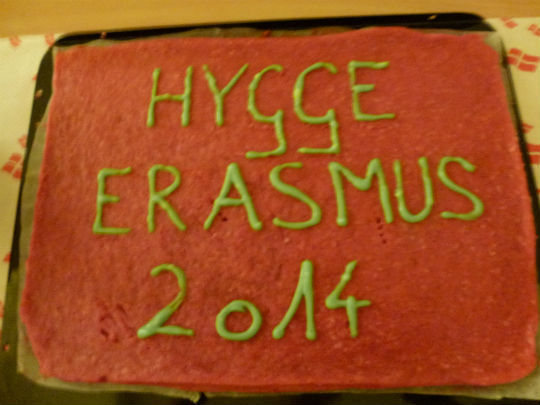 cake "HYGGE" (Photo: Nina Trojer)
cake "HYGGE" (Photo: Nina Trojer)